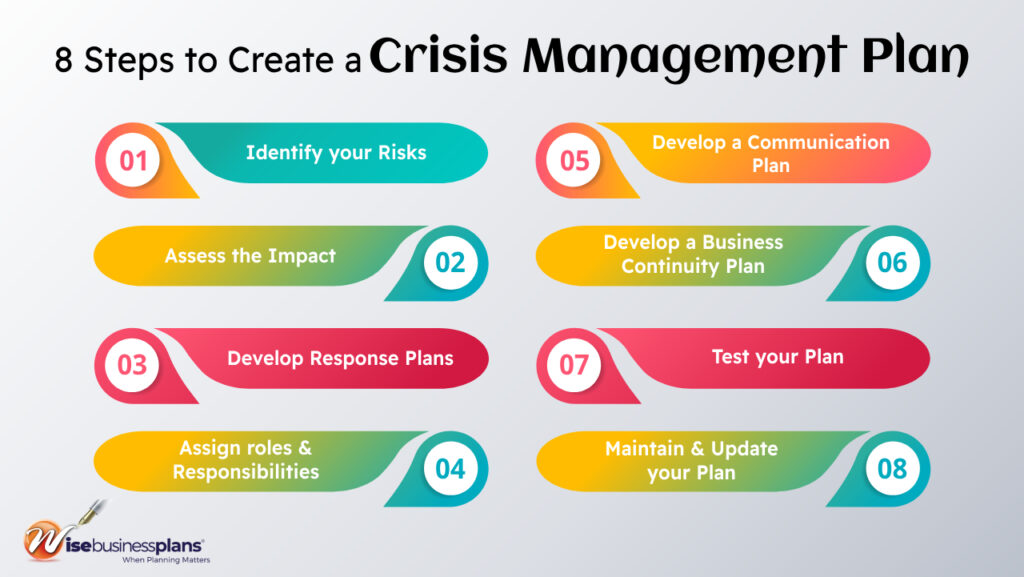8 steps to create a crisis management plan
Table of Contents
- What is a crisis management plan?
- 8 steps to create a crisis management plan
- Step 1: Identify your risks
- Step 2: Assess the impact
- Step 3: Develop response plans
- Looking for someone to create a crisis management plan?
- Step 4: Assign roles and responsibilities
- Step 5: Develop a communication plan
- Step 6: Develop a business continuity plan
- Step 7: Test your plan
- Step 8: Maintain and update your plan
- What to include in a crisis management plan?
- Essential elements of a crisis management plan
- Examples of crisis management plans:
- Need Guidance with Your Business Plan?
- Tips for developing an effective crisis management plan:
- FAQs
In an ever-changing and unpredictable world, organizations, be they large corporations, government agencies, or small businesses, must be prepared to navigate crises that can arise at any moment. A crisis can take many forms, from natural disasters and cyberattacks to financial meltdowns and public relations nightmares. To effectively deal with these turbulent times, organizations rely on a well-structured and comprehensive Crisis Management Plan (CMP).
As a business plan writer and consultant with over 15,000 plans under my belt, I’ve helped businesses of all sizes prepare for the unexpected. In this article, I’ll share my insights on how to create a crisis management business plan for your business.
What is a crisis management plan?
A crisis management plan is a strategy that outlines how a business will respond to a crisis, designating roles and actions to minimize harm and swiftly restore normal operations.
8 steps to create a crisis management plan

-
Step 1: Identify your risks
To identify your risks, you can start by brainstorming a list of all the things that could go wrong. Once you have a list, you can prioritize the risks based on their likelihood of occurring and the potential impact they could have on your organization.
Some common risks to consider include:
- Natural disasters (e.g., hurricanes, floods, earthquakes).
- Cyberattacks.
- Product safety recalls.
- Data breaches.
- Financial crises.
- Public relations crises (e.g., negative media coverage, customer complaints)
- Workplace violence.
-
Step 2: Assess the impact
Once you have identified your risks, you need to assess the potential impact of each scenario on your organization. Consider factors such as:
- Financial losses.
- Reputational damage.
- Disruption to operations.
- Legal liability.
- Impact on employees, customers, and other stakeholders
-
Step 3: Develop response plans
For each crisis scenario, you need to develop a detailed plan for how you will respond. The plan should include the following elements:
- A clear definition of the crisis.
- A list of triggers that will signal the start of the response plan.
- A list of key roles and responsibilities.
- A step-by-step process for responding to the crisis.
- A communication plan for keeping stakeholders informed.
- A business continuity plan for maintaining essential operations.

Looking for someone to create a crisis management plan?
Hire our award-winning professionals to create a crisis management plan!
-
Step 4: Assign roles and responsibilities
It is important to assign specific roles and responsibilities to each member of the crisis management team. This will help to ensure that everyone knows what they need to do in the event of a crisis.
Some common roles and responsibilities include:
- Crisis manager: Responsible for overall coordination of the response effort.
- Communications manager: Responsible for communicating with stakeholders.
- Operations manager: Responsible for maintaining essential operations.
- Security manager: Responsible for ensuring the safety of personnel and assets.
- Legal counsel: Responsible for providing legal advice and support
-
Step 5: Develop a communication plan
Your communication plan should outline who will be responsible for communicating with each group of stakeholders during a crisis, what information will be shared, and how often communications will be sent.
It is important to be transparent and timely with your communications during a crisis. Stakeholders need to know what is happening and what they can do to stay safe.
-
Step 6: Develop a business continuity plan
Your business continuity plan should outline how you will maintain essential operations during a crisis. This may include steps to relocate employees, access backup data, and continue to serve customers.
The goal of the business continuity plan is to minimize the disruption to your business caused by a crisis.
-
Step 7: Test your plan
Once you have developed your crisis management plan, it is important to test it regularly. This will help to identify any gaps or weaknesses in the plan and make necessary adjustments.
Testing the plan can be done through tabletop exercises, simulations, or full-scale drills.
-
Step 8: Maintain and update your plan
Your crisis management plan should be a living document that is regularly reviewed and updated to ensure that it is still relevant and effective.
Changes in your organization or its environment may require you to update your plan. For example, if you acquire a new company or launch a new product, you may need to add new risks to your plan.
By following these steps, you can create a comprehensive and effective crisis management plan that will help your organization to respond to any crisis and recover quickly.
Get our specialized business plan service now!
What to include in a crisis management plan?
A crisis management plan should include a clear and concise definition of what constitutes a crisis for the organization, an identification and assessment of the potential risks that could impact the organization, detailed plans for responding to each identified risk, a clear assignment of roles and responsibilities to key personnel in the event of a crisis, and a plan for communicating with employees, customers, and other stakeholders during a crisis.
-
Essential elements of a crisis management plan
- Crisis definition.
- Risk assessment.
- Response plans.
- Roles and responsibilities.
- Communication plan.
- Business continuity plan.
Additional elements that may be included in a crisis management plan:
- Activation procedures.
- Decision-making process.
- Command and control structure.
- Resource allocation plan.
- Post-crisis review plan.
Examples of crisis management plans:
While it’s impossible to predict every crisis, you can categorize potential crises and create plans to address them. Some crisis management scenarios include:
- Technological Failure: A technology breakdown that disrupts customer access can harm your reputation and finances. It's crucial to prepare for this type of crisis.
- Financial Loss: In the event of a financial setback, such as bankruptcy or employee layoffs, you can have a plan in place to manage these situations, even without knowing the specific cause of the financial crisis.
- Natural Disasters: Depending on your location, you can create crisis plans for natural disasters like hurricanes. These plans may involve evacuation procedures, customer communication strategies, disaster recovery measures, and more.
- Organizational Mishap: When your company faces accusations of misconduct or wrongdoing, you need a plan for addressing these allegations. This may involve issuing a public apology and devising a strategy for recovery.
- Operational Changes: Unexpected leadership changes or a large-scale employee layoff can significantly affect your operations. Having a plan for public communication and adjustment is essential.

Need Guidance with Your Business Plan?
Checkout our 14 free business plan templates!
Tips for developing an effective crisis management plan:
- Involve all relevant stakeholders in the planning process
- be realistic about the organization’s resources and capabilities
- make sure that everyone in the organization knows their roles and responsibilities under the plan
- test the plan regularly and make necessary adjustments
- keep the plan up-to-date to reflect changes in the organization and its environment
FAQs
when creating a crisis management plan for social media, what elements you should start with?
When crafting a crisis management plan for social media, start with:
Team Formation: Assemble a dedicated crisis team.
Identify Potential Crises: Analyze possible social media issues.
Response Guidelines: Establish clear response protocols.
What are the benefits of having a crisis management plan?
A crisis management plan provides:
Proactive Response: It enables a swift and organized response during crises, minimizing damage.
Reputation Protection: Helps maintain trust and brand reputation.
Legal and Regulatory Compliance: Ensures adherence to relevant laws and regulations.
Why is a crisis management plan important for businesses?
A crisis management plan is crucial for businesses because it:
Minimizes Damage: Enables a prompt and organized response to crises, reducing potential harm.
Preserves Reputation: Helps maintain trust and brand integrity during challenging times.
Ensures Preparedness: Ensures businesses are ready to handle unforeseen disruptions effectively.
What are the key elements of a crisis management plan?
A crisis management plan comprises key elements such as risk assessment, a crisis response team, communication strategy, procedures, resource allocation, training, and documentation, all crucial for effective crisis response.
What are the essential components to include in a crisis management plan template?
A crisis management plan template should include key sections like risk assessment, communication protocols, team roles, and resource allocation. It serves as a framework for customizing a crisis response strategy tailored to a specific organization’s needs.

